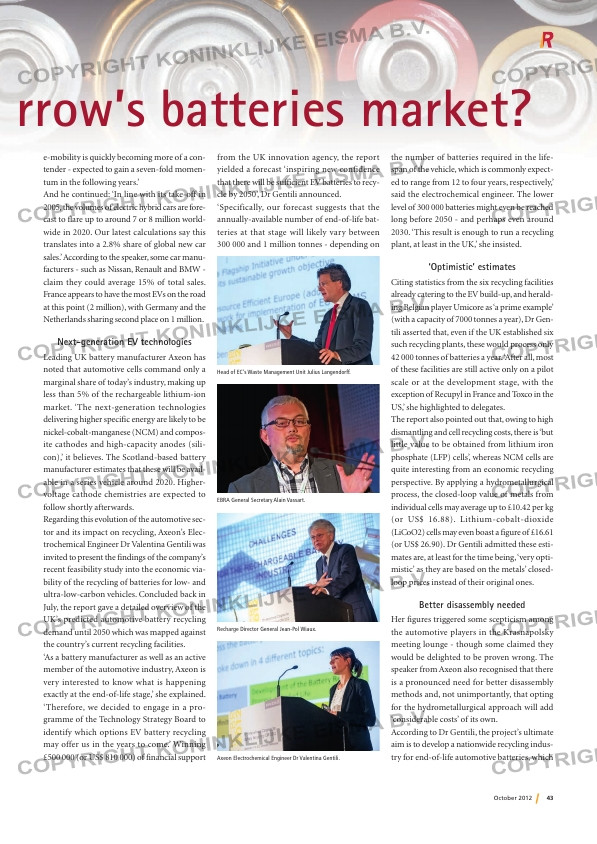Page 43 from: October 2012

43October 2012
More momentum for tomo rrow’s batteries market?
e-mobility is quickly becoming more of a con-
tender – expected to gain a seven-fold momen-
tum in the following years.’
And he continued: ‘In line with its take-off in
2005, the volumes of electric hybrid cars are fore-
cast to flare up to around 7 or 8 million world-
wide in 2020. Our latest calculations say this
translates into a 2.8% share of global new car
sales.’ According to the speaker, some car manu-
facturers – such as Nissan, Renault and BMW –
claim they could average 15% of total sales.
France appears to have the most EVs on the road
at this point (2 million), with Germany and the
Netherlands sharing second place on 1 million.
Next-generation EV technologies
Leading UK battery manufacturer Axeon has
noted that automotive cells command only a
marginal share of today’s industry, making up
less than 5% of the rechargeable lithium-ion
market. ‘The next-generation technologies
delivering higher specific energy are likely to be
nickel-cobalt-manganese (NCM) and compos-
ite cathodes and high-capacity anodes (sili-
con),’ it believes. The Scotland-based battery
manufacturer estimates that these will be avail-
able in a series vehicle around 2020. Higher-
voltage cathode chemistries are expected to
follow shortly afterwards.
Regarding this evolution of the automotive sec-
tor and its impact on recycling, Axeon’s Elec-
trochemical Engineer Dr Valentina Gentili was
invited to present the findings of the company’s
recent feasibility study into the economic via-
bility of the recycling of batteries for low- and
ultra-low-carbon vehicles. Concluded back in
July, the report gave a detailed overview of the
UK’s predicted automotive battery recycling
demand until 2050 which was mapped against
the country’s current recycling facilities.
‘As a battery manufacturer as well as an active
member of the automotive industry, Axeon is
very interested to know what is happening
exactly at the end-of-life stage,’ she explained.
‘Therefore, we decided to engage in a pro-
gramme of the Technology Strategy Board to
identify which options EV battery recycling
may offer us in the years to come.’ Winning
£500 000 (or US$ 810 000) of financial support
from the UK innovation agency, the report
yielded a forecast ‘inspiring new confidence
that there will be sufficient EV batteries to recy-
cle by 2050’, Dr Gentili announced.
‘Specifically, our forecast suggests that the
annually-available number of end-of-life bat-
teries at that stage will likely vary between
300 000 and 1 million tonnes – depending on
Head of EC’s Waste Management Unit Julius Langendorff.
EBRA General Secretary Alain Vassart.
Recharge Director General Jean-Pol Wiaux.
Axeon Electrochemical Engineer Dr Valentina Gentili.
the number of batteries required in the life-
span of the vehicle, which is commonly expect-
ed to range from 12 to four years, respectively,’
said the electrochemical engineer. The lower
level of 300 000 batteries might even be reached
long before 2050 – and perhaps even around
2030. ‘This result is enough to run a recycling
plant, at least in the UK,’ she insisted.
‘Optimistic’ estimates
Citing statistics from the six recycling facilities
already catering to the EV build-up, and herald-
ing Belgian player Umicore as ‘a prime example’
(with a capacity of 7000 tonnes a year), Dr Gen-
tili asserted that, even if the UK established six
such recycling plants, these would process only
42 000 tonnes of batteries a year. ‘After all, most
of these facilities are still active only on a pilot
scale or at the development stage, with the
exception of Recupyl in France and Toxco in the
US,’ she highlighted to delegates.
The report also pointed out that, owing to high
dismantling and cell recycling costs, there is ‘but
little value to be obtained from lithium iron
phosphate (LFP) cells’, whereas NCM cells are
quite interesting from an economic recycling
perspective. By applying a hydrometallurgical
process, the closed-loop value of metals from
individual cells may average up to £10.42 per kg
(or US$ 16.88). Lithium-cobalt-dioxide
(LiCoO2) cells may even boast a figure of £16.61
(or US$ 26.90). Dr Gentili admitted these esti-
mates are, at least for the time being, ‘very opti-
mistic’ as they are based on the metals’ closed-
loop prices instead of their original ones.
Better disassembly needed
Her figures triggered some scepticism among
the automotive players in the Krasnapolsky
meeting lounge – though some claimed they
would be delighted to be proven wrong. The
speaker from Axeon also recognised that there
is a pronounced need for better disassembly
methods and, not unimportantly, that opting
for the hydrometallurgical approach will add
‘considerable costs’ of its own.
According to Dr Gentili, the project’s ultimate
aim is to develop a nationwide recycling indus-
try for end-of-life automotive batteries, which
R _8- in .indd 3 08-10-12 1 :21



